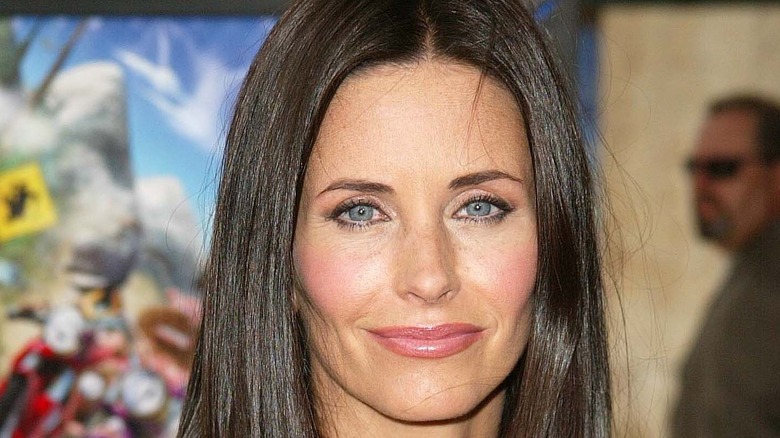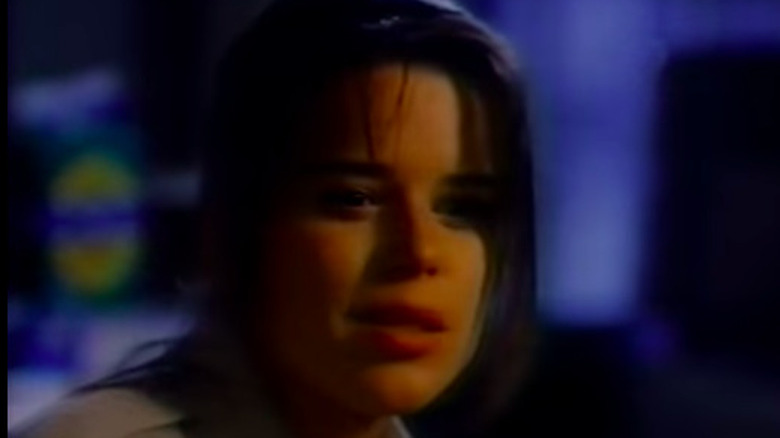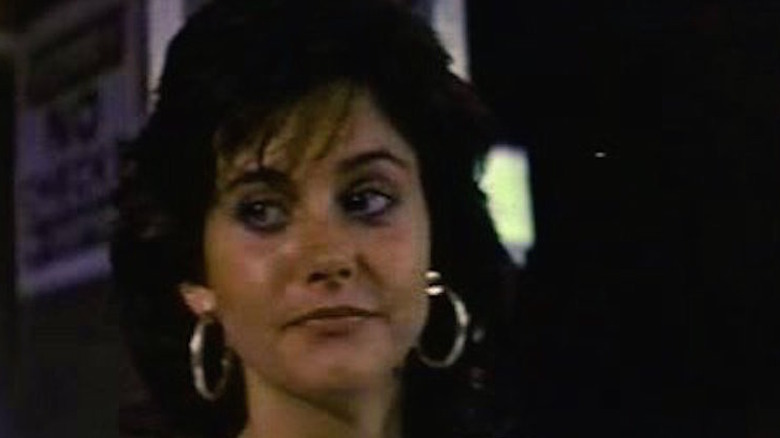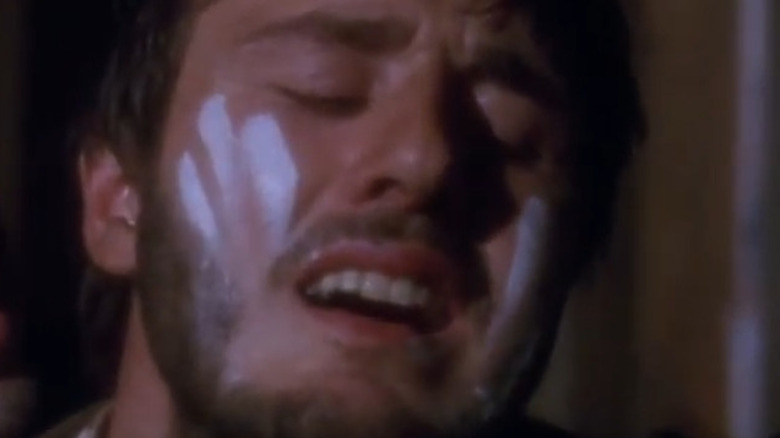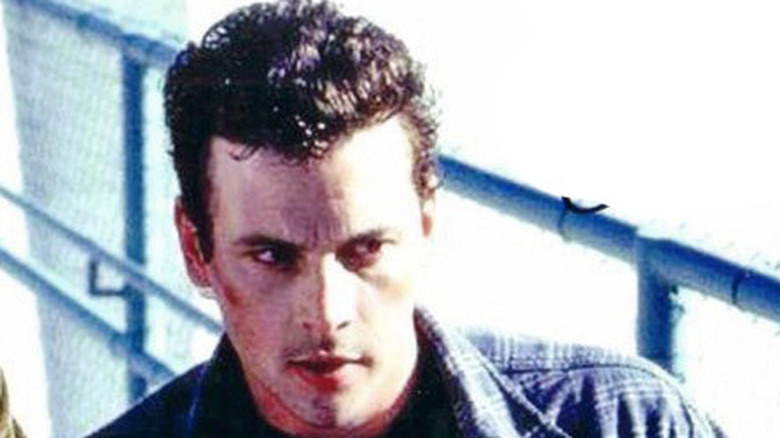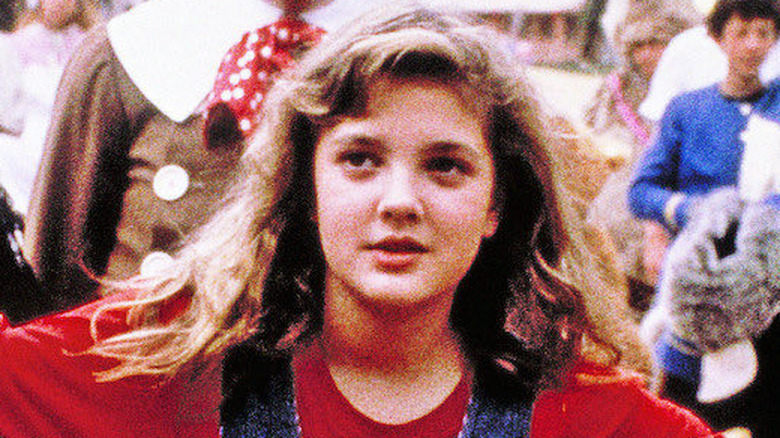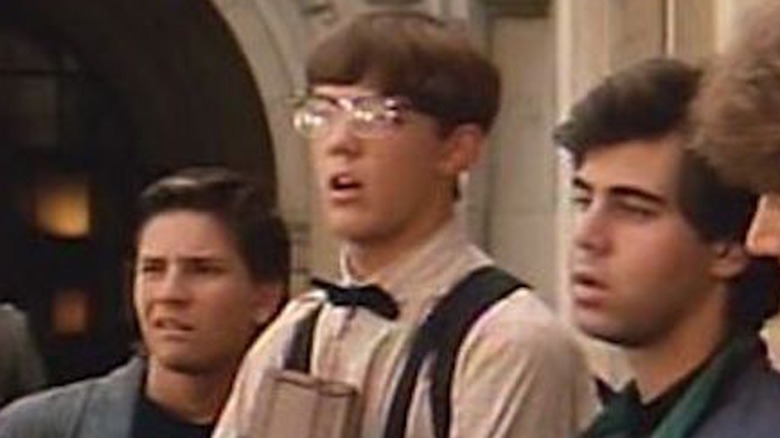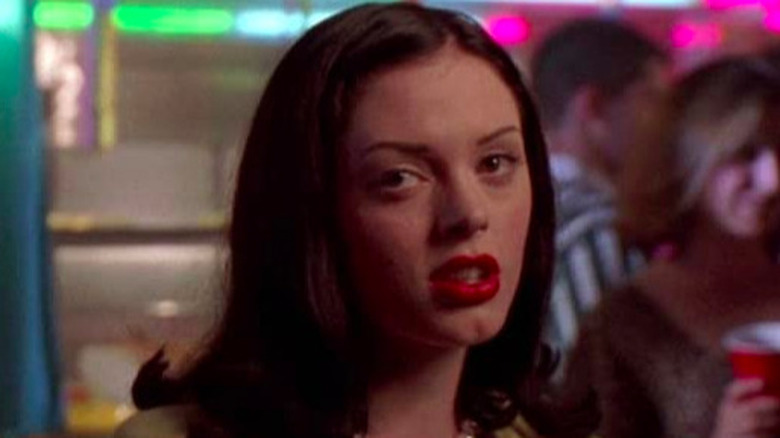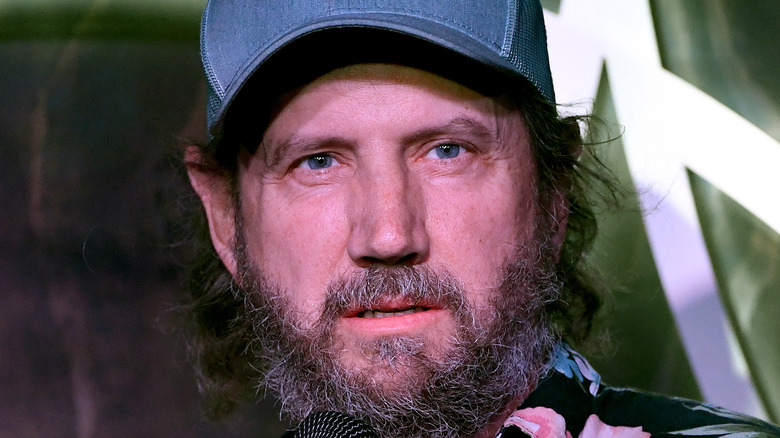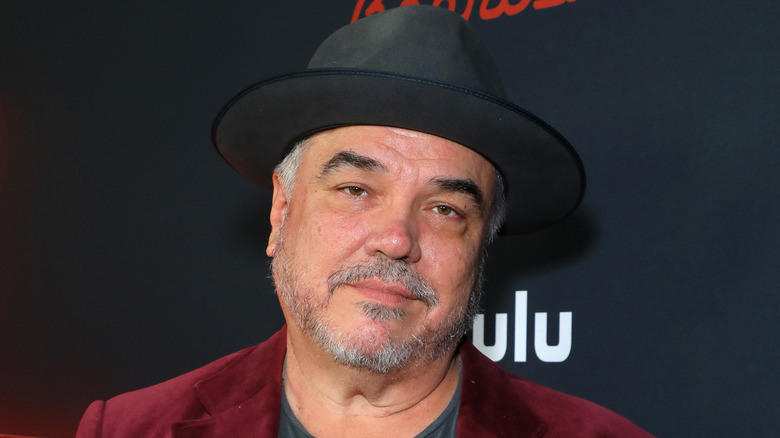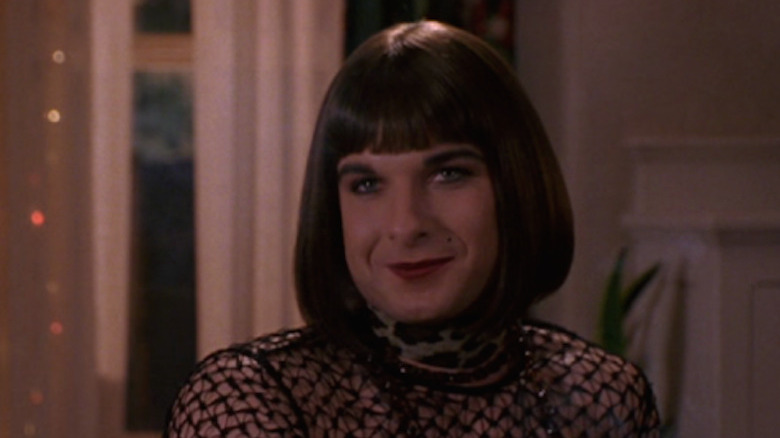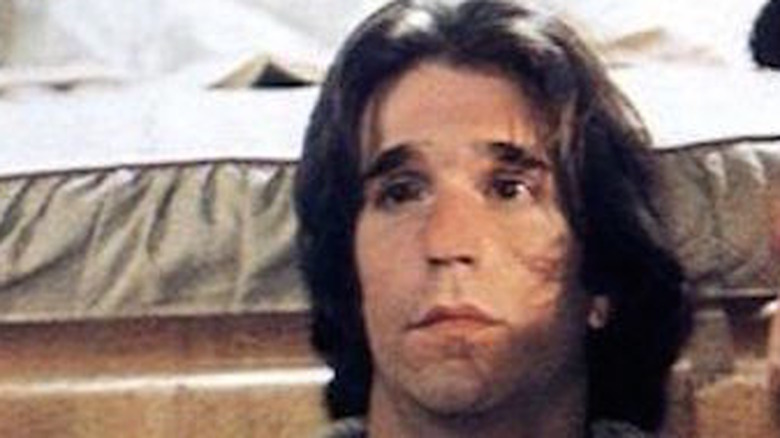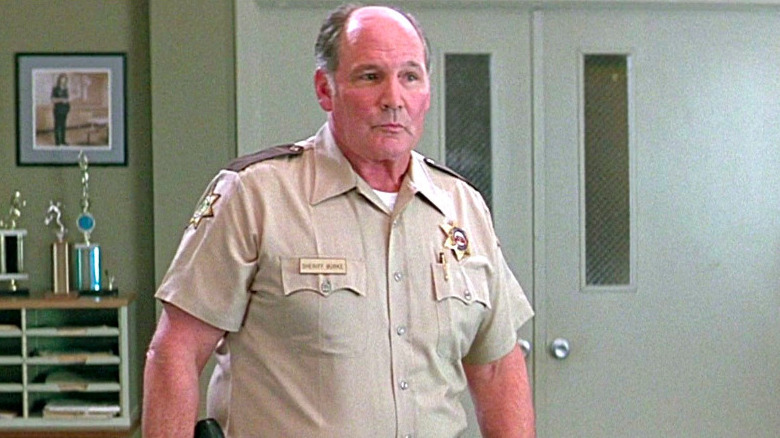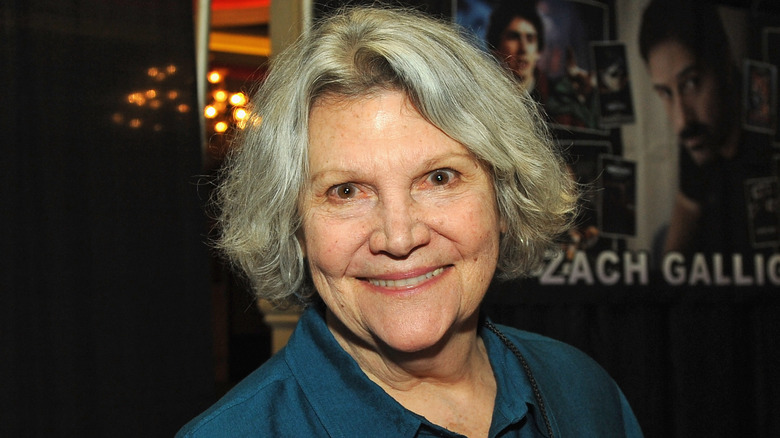Early Roles That Scream Actors Would Like You To Forget About
Wes Craven's 1996 horror flick "Scream" helped revitalize more than just his flagging career and the slasher subgenre he had helped create. It also helped boost many of its primary cast members into something approaching star status. At the time of its release, arguably the most widely-known names in the "Scream" cast were Courteney Cox (playing against her upbeat "Friends" image as reporter Gale Weathers), Drew Barrymore (whose screentime as the ill-fated Casey Becker was short-lived) and Neve Campbell, best known for the modestly successful Fox TV series "Party of Five."
The success of "Scream" helped other cast members rise from relative unknowns to household names, in some cases leading to leads in features. David Arquette (Dewey Riley), Skeet Ulrich (Billy Loomis), Rose McGowan (Tatum Riley), Matthew Lilliard (Stu Macher), and Jamie Kennedy (Randy Meeks) all went on to achieve varying degrees of fame, all far more than they had achieved in the years before Ghostface came calling.
Some of those early appearances came via projects that many of the "Scream" team would like you to pass over if you happen upon them in your streaming searches. No such luck; here is a list of early roles, complete with spoilers, that the stars of "Scream" would very much like you to forget.
It's Neve Campbell vs. a big rat in The Dark
Neve Campbell has faced some formidable opponents over the course of her movie career, including Ghostface, Denise Richards (in "Wild Things"), Malcolm McDowell ("The Company") and Fairuza Balk ("The Craft"). None, however, presented as unique and ridiculous a challenge as a giant rat in the 1993 film "The Dark."
Produced in Campbell's native Canada, "The Dark" stars cult favorites Stephen McHattie ("300") and Brion James ("Blade Runner") as a rogue scientist and hotwired federal agent, respectively, on the trail of an enormous rat that possesses a unique chemistry that heals wounds. It also has a prodigious appetite for humans foolish enough to wander through its lair beneath a graveyard; Campbell plays a deputy who joins in the pursuit of the monster rodent
Campbell's role is secondary in "The Dark," and she strangely appears to be wearing multiple layers under her uniform (some critics have opined that she's wearing a bulletproof vest, but that wouldn't do much good against a man-eating rat). At this point in her career, Campbell had already logged numerous hours in Canadian TV series, including "The Kids in the Hall" and "Are You Afraid of the Dark," and had begun to transition from juvenile roles to more mature characters. "The Dark" marked one of her first turns in such a role, as well as one of the last stops before finding U.S. success in "Party of Five." While the film proved that she could play grown-ups, pitting her against a man in a grubby rat suit might not have been the best showcase for such talents.
Courteney Cox got Down Twisted in her pre-Friends years
Unlike some of her "Friends" co-stars, Courteney Cox enjoyed fame as both a television star and feature film player. "Scream" and its sequels were among her best-known, most profitable big screen projects, but Cox also appeared in "Ace Ventura: Pet Detective" and two Adam Sandler vehicles ("The Longest Yard" and "Bedtime Stories"), all of which enjoyed successful runs at the box office. However, her film resume is also dotted with a number of flops, including "Mr. Destiny," "3000 Miles to Graceland," "The Runner," and "Zoom."
Few films in the latter list qualify as credits that Cox might like fans to pass over; 1987's "Down Twisted," however, might fit the bill. A confused comedy-action film produced by infamous '80s schlock factory Cannon Films and directed by Albert Pyun (who oversaw the '90s-era "Captain America" feature), "Twisted" was a vehicle for actress Carey Lowell, at the time of its release still a few years away from "License to Kill" and "Law & Order." Lowell plays a put-upon Los Angeles waitress who reluctantly partners with ex-"Saturday Night Live" star Charles Rocket (who was famously fired after dropping an f-bomb on the air) to retrieve a stolen religious icon.
Cox's role, as Tarah, is relegated to a single scene. Working with Lowell as a waitress at a diner, the scene is so absurdly chaotic that the pair collide into each other at one point. Later in the same scene, she and another waitress give Lowell a pep talk prior to a job interview. These are forgettable moments in an unmemorable movie, though they do showcase Cox as a fresh-faced talent who could sell deadweight dialogue — and, 3 years prior, had convinced the world that she was simply a lucky fan at a Bruce Springsteen show.
David Arquette fought Civil War zombies in The Grey Knight
"Scream" provided David Arquette with a bona fide hit after nearly a decade as the hard-working if largely anonymous brother of Patricia and Rosanna. He'd appeared in moderately well-regarded films, including 1992's "Buffy the Vampire Slayer" film and Ted Demme's "Beautiful Girls," and appeared in numerous TV projects, including a short-lived series based on "The Outsiders," and the first episodic iteration of Ron Howard's "Parenthood" (in Keanu Reeves' role) opposite Leonardo DiCaprio. Between these efforts, Arquette also logged time in a handful of screen turkeys, including the woebegone crime film "Fall Time" with Mickey Rourke and the 1993 Civil War supernatural thriller "Grey Knight."
Directed by Emmy-winning documentarian George Hickenlooper and co-edited by legendary cult filmmaker Monte Hellman ("Two-Lane Blacktop"), "Grey Knight" drifted through the home video ranks under a number of titles and versions, including "Ghost Brigade," "The Killing Box" and "The Lost Brigade," each searching for an audience that never arrived. In all cases, Hickenlooper's film concerns a curse that reanimates Union and Confederate soldiers during the Civil War for an undead army determined to conquer both sides of the conflict. Union soldier Adrian Pasdar and Confederate prisoner of war Corbin Bernsen lead a squad of soldiers to rout the monster troops.
Arquette and sibling Alexis are among the film's list of supporting soldiers, which also includes Billy Bob Thornton, Dean Cameron ("Summer School"), and Matt LeBlanc, whose participation is relegated to a shot of his corpse hanging upside down from a cross. David Arquette doesn't have much more to do in "Grey Knight," and his character, Murphy, eventually removes himself from the convoluted plot by taking his own life when confronted by the undead soldiers. Arquette does what he can with his brief scene; his panic and terror feels real and generates a moment of genuine sympathy when he realizes his options for survival have run out.
Chill Factor couldn't help Skeet Ulrich keep his cool
Like many of his "Scream" co-stars, Skeet Ulrich, who played the deranged Billy Loomis, rose from supporting player to leading man in the wake of the film's release. His run as a movie star resulted in mostly minor hits and failed efforts, including Paul Schrader's "Touch" and Richard Linklater's "The Newton Boys" (though James Brooks' "As Good As It Gets" became something of a phenomenon). The same can't be said for "Chill Factor," a woeful 1999 buddy action-comedy which asked viewers to believe that the world might be saved by a diner worker (Ulrich), an ice cream man (Cuba Gooding, Jr.) and a plot that felt like re-heated "Speed" leftovers.
Hugh Johnson, who worked with Ridley and Tony Scott as cinematographer and second unit director on films like "G.I. Jane" and "Kingdom of Heaven," made his directorial debut on "Chill Factor," which centers on a super-weapon created by scientist David Paymer. Nicknamed "Elvis," the chemical creates total devastation if it reaches a temperate below fifty degrees. So when it comes time for Paymer to flee terrorist Peter Firth, who wants the weapon, he turns to Ulrich, a man with a murky past and a close buddy to the hyper-caffeinated Gooding (still channeling his Oscar win for "Jerry Maguire"), whose ice cream truck proves to be the ideal hiding place for Elvis.
Ulrich seems out of his element as a man of action in "Chill Factor." Granted, the "Lethal Weapon"-style banter in Drew Gitlin and Mike Cheda's script is dead on arrival (when Ulrich tells Gooding that he can't spring into action because he's been shot, Gooding replies, "Always the negative with you"), but Ulrich can only imitate tough guy poses here, and as a result, doesn't generate much faith in his save-the-day abilities. He has always fared much better as characters who struggle with being put into heroic (or villainous) positions, like his roles in the cult series "Jericho" and "Riverdale."
Drew Barrymore sang and saved Keanu Reeves in Babes in Toyland
The first of many terrific surprises and twists in "Scream" comes in the opening moments of the film, when Ghostface torments and dispatches high schooler Casey Becker. Casey is played by Drew Barrymore, who at the time of release was once again on the rise, having finally overcome the post-"E.T." childhood problems that famously plagued her to emerge as a sexy "it girl" of the moment via films like "Poison Ivy" and public appearances like an infamous flashing of David Letterman. Much like "Psycho" in the early '60s, the notion that a recognizable star would be killed off in the film's opening moments gave the film an anything-can-happen flavor.
Barrymore, of course, established her star status in the 1980s as a child actor not only in the Spielberg classic but also films like "Firestarter" and "Cat's Eye." Landing, albeit with a thud, during this time period was also "Babes in Toyland," a 1986 TV movie adaptation of the Victor Herbert operetta, which had been previously adapted for film and television on numerous occasions, including a vehicle for Laurel and Hardy in 1934 and by Walt Disney Productions in 1961.
The 1986 TV adaptation by director Clive Owen removes most of Victor Herbert's score and gives its audience new musical numbers by Leslie Bricusse for Barrymore and co-stars Keanu Reeves (yes, really) and Pat Morita (ditto) to lip-sync. Barrymore's character is new to the story as well: she's a modern-day girl transported to Toyland after a car accident, all the better to aid Keanu in stopping Richard Mulligan (of "Empty Nest" fame) from taking over Toyland and carrying off Jill Schoelen (of "The Stepfather" fame). Barrymore looks supremely uncomfortable with her sugary role and songs, though in her defense, everyone in the film looks like they're acting at gunpoint. She fares slightly better in the film's uncomfortably scary-for-kids moments opposite Mulligan's one-eyed bird monster or henchmen, who resemble the vampire in the 1921 silent "Nosferatu."
Mini-monsters schooled Matthew Lillard in Ghoulies 3: Ghoulies Go to College
"Ghoulies III: Ghoulies Go to College" is the third entry in a goofy, toilet-fixated series of mostly unrelated comedy-horror films about tiny, rowdy demons. Drawing heavily on the "Gremlins" films for inspiration, the franchise found success in the video store heydays, when a cover box could be as instrumental to a title's success as its script. Initially produced by Charles Band's Empire Pictures, the first "Ghoulies" provided Mariska Hargitay with her screen debut, while 1990's "Ghoulies III" kicked off Matthew Lillard's feature film career.
Lillard is a glorified extra in "Ghoulies III," playing a bespectacled nerd credited as "Stork" in scenes involving the college pranks that kick the picture's story into motion (Professor Kevin McCarthy invokes the little monsters to stop his school's frats from running amuck). In a 2017 interview with the Los Angeles Times, Lillard said that the long hours on the film (being [aid $50/day) helped him qualify for a Taft-Hartley form, which allows actors entry into SAG-AFTRA, the Screen Actors' Guild labor union.
Though essentially a background player, Lillard invests the character with his trademark wild-eyed energy, which helps him to stand out in a cast anchored by a mix of bland players, up-and-comers (Jason Scott Lee, Eva La Rue) and go-for-broke hams like McCarthy and Marcia Wallace (who at one point is strangled with her own tongue). However, the film's acting honors belong to Richard Kind and voice acting vets Bob Bergin and Patrick Kind, who lend their talents to the film's beer-guzzling Ghoulies.
Rose McGowan was trapped with Pauly Shore in Bio-Dome
A surprisingly large number of talented actors put aside their career concerns to appear in the 1996 comedy "Bio-Dome." Of course, it should be pointed out that in the early '90s, Pauly Shore was one of the hottest rising talents in Hollywood.
Among the performers whose representation considered it a wise move to support Shore in this witless feature ("Bio-Dome" signaled the end of a period that had him headlining vehicles like "Son in Law" and "In The Army Now") were Joey Lauren Adams, William Atherton ("Ghostbusters"), singer Kylie Minogue, Jack Black, voice actors Phil LaMarr and Rodger Bumpass, and even Stephen Baldwin, who would shoulder 50 percent of the blame for this film as Shore's alarmingly dim sidekick. Baldwin claimed in 2008 (via The A.V. Club) that it was God's plan for him to appear in the picture and, for whatever reason, wants a sequel.
Rose McGowan, who played Tatum in "Scream," also appears in "Bio-Dome" as the short-tempered Denise, whom the filmmakers want audiences to believe is "uptight" because she wears a conservative dress and strand of pearls. She's a friend of Shore and Baldwin's significant others (Adams and Teresa Hill) and who quite rightly wants them to forget about the idiotic pair. In that sense, Denise is the most intelligent character in the film (even more so that the team of Bio-Dome scientists). The script doesn't give McGowan much to do beyond looking pert and flashing malevolent looks, but she's as committed to the material as anyone might be in such a silly project. Fans of McGowan might note that Denise is more or less a dry run for her similarly icy role in the slightly more tolerable "Jawbreaker."
Jamie Kennedy struggles to shine in Sparkler
Before trudging on its current downward path, which encompasses such grim efforts as "Tremors: A Cold Day in Hell" and "Last Call," Jamie Kennedy's film career included such critical and box office hits as ""Three Kings," "As Good As It Gets," "Bowfinger," and of course, the "Scream" series. He played Randy Meeks, whose horror film fandom provided his fellow teens with the rules for survival in a slasher picture (not that they minded any of them). He reprised the role in "Scream 2" before being dispatched by Mrs. Loomis.
The popularity of the "Scream" pictures led to steady film work for Kennedy in the decade-plus after their release, though not all of his features were in the same league as the aforementioned hits. Case in point: "Sparkler," a 1997 comedy directed and co-written by Darren Stein of "Jawbreaker" fame. Stage and TV actress Park Overall stars as a trailer park resident who rebounds from her husband's infidelity when she's advised by a psychic to keep an eye out for "three kings." She believes she's found her salvation upon meeting a trio (Kennedy, Freddie Prinze, Jr., and Steven Petrarca) from Los Angeles who hope to win rent money in Vegas. Their adventures together found no favor with audiences or critics, which sent "Sparkler" to the bottom of the ranks on Rotten Tomatoes, where it currently sits with a 17% rating.
Kennedy is prominently featured on the home video cover art for "Sparkler," but he's in support mode here, though his turn as the dejected sidekick to Prinze's self-inflated would-be talent agent gives him a chance to exercise his comic talents. Despite his best efforts, the role is underfed and clichéd; he's a big-city jerk who finds redemption in Overall's relentless good cheer, which is a sweet if totally implausible notion.
W. Earl Brown nearly escaped The Woman Who Loved Elvis
"Scream" was actor W. Earl Brown's third project with Wes Craven. The hard-working character player appeared as a morgue attendant in "Wes Craven's New Nightmare" in 1994 and turned up in his ill-fated "Vampire in Brooklyn" in '95 before signing on to play cameraman Kenny Brown in "Scream." Kenny aids Gale Weathers in her tabloid reporting on the murders, eventually helping Sidney escape Ghostface at the cost of his own life.
Brown's long list of credits include his three-season run as Dan Dority on "Deadwood," films ranging from "There's Something About Mary" and "Wild," and recent appearances on both "The Mandalorian" and "The Book of Boba Fett" (as the Weequay bartender Taanti). With so many credits to his name, it's only logical that Brown would appear in a few turkeys, and the 1993 TV-movie "The Woman Who Loved Elvis" definitely qualifies as that species of fowl.
A treacle-heavy comedy-drama based on the 1992 novel "Graced Land" by Laura Kalpakian, "The Woman Who Loved Elvis" was fashioned as a vehicle for stars (and then-married couple) Roseanne Barr and Tom Arnold. Barr plays a small town mom and Elvis obsessive who jockeys with the welfare system to make ends meet, while Arnold plays it straight as her ex-husband. Actor Bill Bixby (who appeared opposite Elvis in "Speedway" and "Clambake") maintains a steady hand over the cast, which includes Cynthia Gibb, future "Halloween" franchise star Danielle Harris, and Brown as Pete, who turns up briefly in the film's final moments.
Pete is only a bit role for Brown, as the lumpish rebound boyfriend of Monica McCarthy's small town vixen Dorrie after her breakup from Arnold. Pete is, on paper, a cartoon, another one of the movie's broad stereotypes of Middle America. However, Brown shrewdly adds layers to his performance; he talks tough to Roseanne but also appears uncertain about taking custody of Dorrie and Arnold's kids, which in those brief moments, underscores his ability to bring nuance and life to even the smallest role.
Liev Schreiber's first feature was an all-star flop
Most accounts of Liev Schreiber's film career note that he appeared in a string of independent features, including "Party Girl" and "Big Night," before making his studio debut as accused murderer Cotton Weary in the "Scream" franchise. That's not entirely true, as Schreiber was a well-regarded stage actor before making his feature film debut in the little-seen Steve Martin dud "Mixed Nuts" in 1994.
At first blush, it's a mystery why "Mixed Nuts" wallows in such obscurity. Written and directed by Nora Ephron (who earned an Oscar nomination for writing "When Harry Met Sally" and had become her own directorial brand with films like "Sleepless in Seattle"), the comedy features an all-star cast led by Martin and featuring, among others, Adam Sandler, Rita Wilson, Juliette Lewis, Garry Shandling, and Madeline Kahn. Schreiber plays a trans character, Chris, who becomes embroiled in a series of mishaps that pull together the other characters during a frantic Christmas.
Schreiber and his castmates play their off-kilter roles to the hilt. However, they're all stranded in a perversely weird script which anchors around a suicide prevention hotline and its frequent callers. There's also a serial killer on the loose in "Mixed Nuts," all of which sits uncomfortably with broadly comic scenes of Schreiber dancing a foxtrot with Martin, Kahn rapping while trapped in an elevator, and Sandler dressed in a gondolier costume while playing a ukulele. All the moving parts in "Mixed Nuts" collide rather than gel, leaving a pileup of talented comic actors in disarray.
Henry Winkler fought for laughs in Heroes
Henry Winkler's uncredited appearance as doomed high school principal Arthur Himbry in "Scream" came at what might now be considered a midpoint in his screen career. Winkler rocketed to fame in the 1970s as Arthur Fonzarelli on "Happy Days," but struggled to find substantive work in the wake of the show's success. He moved behind the camera, earning Daytime Emmys for directing a 1985 episode of the "CBS Schoolbreak Special" and producing the reboot of "Hollywood Squares." In the years since, he bas built momentum with an Emmy nod for his appearance on "The Practice," collaborations with Adam Sandler ("The Waterboy") and a revival of his acting career, which has led to "Arrested Development," "Better Late than Never," and an Emmy win for "Barry."
Winkler's movie appearances during and immediately following "Happy Days" appeared to aim directly for roles that were direct opposites of the Fonz. He was an egotistical actor who became a professional wrestler in "The One and Only" and a put-upon morgue supervisor in Ron Howard's "Night Shift." The oddest of his short list of early movie roles, however, was unquestionably "Heroes," a 1977 comedy-drama that starred Winkler as a Vietnam War veteran suffering from post-traumatic stress disorder.
Jeremy Paul Kagan's film operates on the well-worn cliché that the mentally ill have greater insight into truth and reality than others, and the script by James Carabatsos ("Heartbreak Ridge") views Winkler's erratic behavior, which includes escaping from a hospital and experiencing a harrowing battlefield flashback, as signs of great insight. Though played with great energy, Winkler's actions befuddle the other players, including Sally Field as a would-be romantic interest and Harrison Ford as a fellow vet, which is essentially how viewers will come away from this heavy-handed effort.
Joseph Whipp got a workout in Death Spa
Burly character actor Joseph Whipp's turn as Sheriff Burke in "Scream" was just one of several collaborations with director Wes Craven. The actor played another police officer in 1984's "A Nightmare on Elm Street" and appeared in the 1985 TV-movie "Chiller" and an episode of the "Twilight Zone" revival directed by Craven before joining the cast of "Scream" in 1996. Between and before these projects, Whipp also appeared in dozens of features and TV series, ranging from "Escape from Alcatraz" and "The Hidden" to "Cheers," "Santa Barbara," and "Baywatch."
Arguably, the strangest title in Whipp's long list of credits is "Death Spa," a 1988 supernatural horror film that posts the intriguing question, "Can a health club inspire the same degree of chills as a haunted house?" Well, that all depends on your definition of chills, but "Death Spa" does stand out because of its truly one-of-a-kind plot. The titular location becomes a "Death Spa" after the wife (Sharri Shattuck) of its owner (William Bummiler) commits suicide and her spirit possesses the supercomputer that oversees all of the spa's function. If you're wondering, "Why a spa?" or any other questions about this film, you'll find your answers in this oral history of the film.
Shattuck's ghost bumps off most the film's supporting cast via spa and gym equipment; heads compress due to extreme heat (or something along those lines) in a sauna, shower ties nearly slice occupants to ribbons, workout machines crush an exercise nut, and in one of the most logic-defying scenes, a box of frozen eels returns to life and attacks a man trapped in the freezer. Whipp, as the wonderfully named and very intense paranormal investigator Dr. Lido Moray, gets away relatively easy; Shattuck's ghost somehow causes his gun to explode, leaving him with a pulped hand that makes it difficult for him to tote his curious-shaped ghost detecting machine. Whipp's role is almost a weird after-thought, reminding viewers that "Death Spa" is a supernatural film, not a slasher movie, and once he's fulfilled that purpose, he's shuttled off-screen in a splash of gore.
Movie mom queen Frances Lee McCain made it through It Takes Two
The role of Mrs. Riley, doting mother to both Dewey and Tatum in "Scream," added another Movie Mom to actress Frances Lee McCain's long list of credits. She hit her motion picture matriarch stride in the 1980s, playing Kevin Bacon's mom in "Footloose," Zach Galligan's mom in "Gremlins," Corey Feldman's mom in "Stand By Me," and Michael J. Fox's grandmother in "Back to the Future." She played roles other than major characters' parents in some films, most notably "Patch Adams" and "True Crime," but remains best known as one of the big screen's busiest mothers.
McCain is also a mom in the very weird 1988 comedy "It Takes Two," which cast her as the mother of nervous newlywed-to-be George Newbern (of the "Father of the Bride" series). Newbern is about to marry his childhood sweetheart (Leslie Hope from "24") but decides to sink much of his hard-earned money into a souped-up sports car (a "Lamborghini knockoff"). The very '80s-vixen-styled salesperson (future soap star Kimberly Foster) takes him out for a test drive, which proves both literal and figurative, since both skip town and get hot and heavy in what seems like only seconds.
Their flash romance also goes flat in a hurry when the car proves to be a dud and strands them in a Hollywood version of the rural Southwest, which is full of open fires and lunatics like "General Hospital" star Anthony Geary, who repairs the car but also blows up the dealership. Newbern and Foster head back for his wedding, and ... he gets married. Yep, forgets all about their previous adventure. Roll credits.
McCain's role is minor in "It Takes Two." She's there primarily to emphasize that Newbern is a naive mama's boy and therefore ripe for the picking for seductive blondes like Foster. McCain spends much of her screen time fretting up a storm when Newbern misses various rehearsals and pre-ceremony events. It's a role that could have been handled by anyone, but she invests it with the warmth that made her a go-to movie mom for decades.
